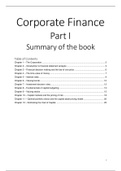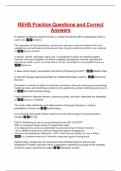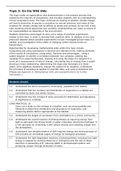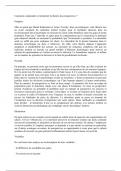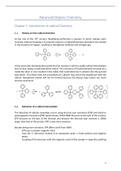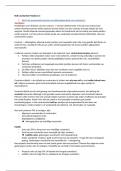Part I
Summary of the book
Table of Contents
Chapter 1 – The Corporation............................................................................................................ 2
Chapter 2 – Introduction to financial statement analysis ................................................................. 3
Chapter 3 – Financial decision making and the law of one price .................................................... 6
Chapter 4 – The time value of money .............................................................................................. 7
Chapter 5 – Interest rates................................................................................................................. 9
Chapter 6 – Valuing bonds ............................................................................................................. 10
Chapter 7 – Investment decision rules ........................................................................................... 12
Chapter 8 – Fundamentals of capital budgeting ............................................................................ 13
Chapter 9 – Valuing stocks ............................................................................................................ 15
Chapter 10 – Capital markets and the pricing of risk ..................................................................... 18
Chapter 11 – Optimal portfolio choice and the capital asset pricing model................................... 20
Chapter 12 – Estimating the Cost of Capital .................................................................................. 25
1
,Chapter 1 – The Corporation
1.1 The four types of firms
• Sole proprietorships is owned and run by one person.
This makes up 72% of the businesses in the US but they
only generate 4% of the revenue. Key features:
o Straightforward to set up
o No separation between firm and owner
o The owner has unlimited personal liability for any of
he firm’s debts.
o Life of a sole proprietorship is limited to the life of the owner.
o Disadvantages outweigh the advantages: convert into a form that limits the owner’s liability
• Partnerships is identical to sole proprietorships but has more than one owner. Key features:
o All partners are liable for the firm’s debt
o Partnership ends on the death or withdrawal of any single partner, unless the agreement provides for
alternatives (e.g. buyout).
o Some business remain sole proprietorships or partnership because the owners’ personal reputations
are the basis (e.g. law firms, doctors).
A limited partnership is a partnership with two kinds of owners, general partners and limited partners.
General partners have the same rights and privileges as a general partnership, but limited partners have
limited liability (their liability is limited to their investment), death does not dissolve partnership, no
management authority and not legally involved.
• Limited liability companies (LLC) is a limited partnership without a general partner. The owners have
limited liability but can run the business.
• Corporations are legally defined, artificial being, separate from its owners. It has many of the legal powers
that people have, and the owners of a corporation are not liable for any obligations. A corporation must be
formed legally which makes it costly. Owners are called shareholders, stockholders or equity holders and
receive dividend payments, proportional to their amount of stock. Investors can be anyone and anonymous
is possible.
A corporation first pays tax on its profits and next the shareholders pay tax on their own personal income
(double taxation). ‘S’ corporations are an exemption. The firm’s profits are directly allocated to
shareholders and the shareholders include these profits as income on their individual tax returns. You can
only qualify for this treatment if there are maximum 100 shareholders who are all U.S. residents. Large
corporations are called ‘C’ corporations.
1.2 Ownership versus control of corporations
Shareholders vote for the election of the board of directors (more
shares = more influence) and can even be on the board themselves.
This board delegate decisions related to day-to-day running. The
chief executive officer (CEO) is charged with running the corporation
by instituting the rules and policies set by the board of directors. The
financial managers are responsible for making investment decisions,
making financial decisions and managing the firm’s cash flows. The
most senior financial manager is the chief financial officer (CFO).
Most shareholders agree that they are better off if management makes decisions that increase the value of their
shares. These decisions must also benefit the society overall. There can be an agency problem if managers put
their own self-interest ahead of the interests of shareholders. This problem can be addressed by minimizing the
difference between self-interest and interest of the shareholders, e.g. bonus top managers based on stock price.
However, tying compensation to performance can result in more risk taking. Conflicts of interest and ethical
considerations can also arise if some stakeholders benefit and others lose from decisions.
A weak performance of the CEO can result in a forced resign of in a decrease in stock prices. The stock price of
the corporation is a barometer for corporate leaders that continuously gives them feedback on their shareholders’
2
, opinion of their performance. If the stock prices are very low and the CEO is not replaced, there can be a hostile
takeover if someone buys a large fraction of the stocks and replaces the board of directors and CEO.
If a corporation borrows money, the holders of the firm’s debt also become investors. If the corporation fails to
repay the debts, the debt holders are entitled to seize their assets until there is a change in ownership. Thus,
bankruptcy doesn’t need to result in a liquidation (shutting down the business). As long as the corporation can
satisfy the claims of the debt holders, ownership remains in the hands of the equity holders.
1.3 The stock market
Shareholders want to maximize the value of their investments, which is determined by the price of the stock.
Private companies barely trade their shares but public companies trade their shares on a stock market. This
market is liquid because it is possible to sell shares quickly and easily. The corporation itself sells shares of
stocks on the primary market to investors. Next, investors trade with other investors in a secondary market.
In the NYSE, one market maker per stock matches buyers and sellers, using the bid price and the ask price.
The trade is made, even if there is no other customer to take other side of the trade. This provides liquidity. In the
NASDAQ, multiple market makers can compete with their bid and ask prices. Market makers make money
because ask prices are higher than bid prices (= bid-ask spread), this are the transaction costs. Nowadays, there
are many more markets and transactions occur electronically. You can post a limit order (set amount at a fixed
price), the highest and lowest limit orders determine the bid and ask prices, this provides liquidity. You will receive
the bid-ask spread, but it’s a risk if the stock prices move. Therefore, you will constantly have to update the limit
order (high frequency traders (HFTs)). The collection of all limit order is called the limit order book, which is
public. Dark pools don’t make their limit order books visible and give a better price, but it could be that the order
will not be filled. You can also place a market order (trade with best limit order), which makes you a taker of
liquidity.
Chapter 2 – Introduction to financial statement analysis
2.1 Firm’s disclosure of financial information
Financial statements are accounting reports with past performance information. An annual report must be send
to the shareholders each year and to the U.S. SEC. Generally Accepted Accounting Principles (GAAP)
provide a common set of rules and a standard format for public companies, which makes comparison easier. An
auditor (neutral third party) checks the annual financial statements. There are four financial statements: the
balance sheet, the income statement, the statement of cash flows and the statement of stockholders’ equity.
2.2. The balance sheet or statement of financial position
The balance sheet lists the firm’s …:
• Assets. Includes cash, inventory, property, plant and equipment. Shows how firm uses its capital.
o Current assets = within one year. Includes cash and other marketable securities, accounts receivable
(purchase on credit), inventories.
o Long-term assets = more than one year. The value of real estate or machinery reduces over time, thus
a depreciation expense is deducted. This results in net property, plant and equipment ( = book value).
Goodwill and intangible assets show the difference between the paid price for another company and the
book value assigned to its tangible assets. If this will decline by time, amortization or impairment charge
is added to the balance sheet.
• Liabilities. Includes obligations to
creditors. Shows the sources of
capital.
o Current liabilities = within one
year. Includes accounts payable
(purchase on credit), short-term
debt or notes payable, current
maturities of long-term debt
(repayments of debts < 1 year),
and e.g. salaries or taxes that still
need to be paid.
3



